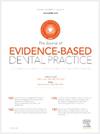牙龈内阿米巴和毛滴虫与牙周炎和牙龈炎的关系:一项系统综述、荟萃分析和荟萃回归
IF 4
4区 医学
Q1 DENTISTRY, ORAL SURGERY & MEDICINE
引用次数: 0
摘要
引言尽管有许多研究调查了齿龈内阿米巴和肌腱毛滴虫与牙周疾病之间的联系,但研究结果仍不确定。为了解决这种不一致性,我们进行了一项荟萃分析,以评估牙龈卟啉单胞菌和T.tenax与牙龈炎和牙周炎之间的关联。方法我们搜索了Google Scholar、Medline/PubMed、Scopus、Web of Science和Embase搜索引擎和数据库,以及自其成立之日起至2024年4月20日的相关文章的书目部分。使用纽卡斯尔-渥太华量表对纳入的研究进行了潜在偏差和证据总体质量的评估。最后,20项研究进入了荟萃分析。结果20项研究符合纳入本研究的条件。在牙龈炎患者中,T.tenax的患病率估计为14%(95%CI:8-20),在牙周炎患者中为26%(95%CI:12-40)。据估计,T.tenax感染患者患牙龈炎和牙周炎的几率明显高于对照组(OR:2.30;95%CI:1.21-4.35,OR:2.90;95%CI:1.01-8.37)。此外,牙龈炎患者中牙龈单胞菌的患病率估计为45%(95%CI:32-58),牙周炎患者中为55%(95%CI:35-75)。据估计,感染牙龈单胞菌的患者患牙龈炎和牙周炎的几率明显高于对照组(OR:4.08;95%CI:2.36-7.06,OR:8.33;95%CI:3.04-22.81)。结论我们的分析表明,感染牙龈卟啉单胞菌或T.tenax的人比非感染者更容易患牙周病。PROSPERO注册号CRD42024551772本文章由计算机程序翻译,如有差异,请以英文原文为准。
THE RELATIONSHIP BETWEEN ENTAMOEBA GINGIVALIS AND TRICHOMONAS TENAX WITH PERIODONTITIS AND GINGIVITIS: A SYSTEMATIC REVIEW, META-ANALYSIS, AND META-REGRESSION
Introduction
Despite numerous studies investigating the link between Entamoeba gingivalis and Trichomonas tenax and periodontal diseases, findings remain inconclusive. To resolve this inconsistency, we conducted a meta-analysis to assess the association between E. gingivalis and T. tenax with both gingivitis and periodontitis.
Methods
We searched Google Scholar, Medline/PubMed, Scopus, Web of Science, and Embase search engines and databases, as well as a bibliographic section of related articles from their dates of inception to 20 April 2024. The included studies were assessed for potential biases and the overall quality of the evidence using the Newcastle-Ottawa Scale. Finally, 20 studies entered the meta-analysis.
Results
20 studies were qualified to be included in the current study. The prevalence of T. tenax was estimated to be 14% (95% CI: 8-20) among gingivitis patients and 26% (95% CI: 12-40) in periodontitis patients. The odds of gingivitis and periodontitis were estimated to be significantly higher in patients with T. tenax infection than in the control group (OR: 2.30; 95% CI: 1.21-4.35, and OR: 2.90; 95% CI: 1.01-8.37, respectively). Also, the prevalence of E. gingivalis was estimated to be 45% (95% CI: 32-58) among gingivitis patients and 55% (95% CI: 35-75) in periodontitis patients. The odds of gingivitis and periodontitis were estimated to be significantly higher in patients with E. gingivalis infection than in the control group (OR: 4.08; 95% CI: 2.36-7.06, and OR: 8.33; 95% CI: 3.04-22.81, respectively).
Conclusion
Our analysis shows that individuals infected with E. gingivalis or T. tenax are more prone to periodontal diseases than noninfected individuals.
PROSPERO Registration ID
CRD42024551772
求助全文
通过发布文献求助,成功后即可免费获取论文全文。
去求助
来源期刊

Journal of Evidence-Based Dental Practice
DENTISTRY, ORAL SURGERY & MEDICINE-
CiteScore
6.00
自引率
16.70%
发文量
105
审稿时长
28 days
期刊介绍:
The Journal of Evidence-Based Dental Practice presents timely original articles, as well as reviews of articles on the results and outcomes of clinical procedures and treatment. The Journal advocates the use or rejection of a procedure based on solid, clinical evidence found in literature. The Journal''s dynamic operating principles are explicitness in process and objectives, publication of the highest-quality reviews and original articles, and an emphasis on objectivity.
 求助内容:
求助内容: 应助结果提醒方式:
应助结果提醒方式:


